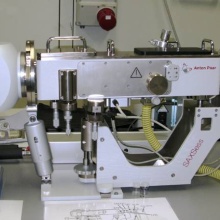Small angle scattering in general allows determining structure and dynamics on colloidal length scales. In the case of X-ray the well defined, collimated primary beam is scattered by electrons. Hence the intensity of the scattered beam depends on the electron-density inhomogeneities in the sample. The relationship between the scattering angle and the size of the investigated sample is reciprocal, i.e. small structures scatter at high angles and large structures scatter at low angles. Compared to the X-ray wavelength colloidal dimensions are comparably large giving us a range of the scattering angle between 0.05°-10° (small angle regime) and 0.05°-41° (small and wide angle regime). We analyze the experimental data using the Indirect Fourier Transformation, the Generalized Indirect Fourier Transformation [1, 2]. From the obtained fit functtions we get information about shape and size of the particles and their interactions. For microemulsions we may also apply the Teubner-Strey model [3] from which the domain sizes and the correlation lengths in a bicontinuous sample can be derived. The following figure shows the typical scattering curve of a droplet microemulsion with a single broad correlation peak [4].
The SAXSess system offers two different types of collimations, point and line collimation. We are mostly operating the system in line collimation, which allows us achieving higher scattering intensities that are advantageous for isotropic samples of low scattering power or for kinetic measurements. The system is equipped with a semi-transparent beam stop to attenuate the intensity of the primary beam down to the same order of magnitude as the scattered intensity, which increases the quality of the obtained scattering curve and sets the zero angle position. The collimation system used in the SAXSess consists of a bent-multilayer mirror, which focuses and monochromatizes the X-ray beam coming from the X-ray source and a collimation block with polished slits based on the well-known Kratky system, which reduces parasitic background scattering. The SAXSess system is illustrated in the following figure taken from [2].
Basic features [5]:
- CCD detector, PI-SCX, Roper, resolution 2084x2084, pixel size 24x24 μm2
- Image plate reader for wide angle measurements
- Temperature control unit -30°C-120°C
- Flow-cell
- Paste cell
- Rotating cell
- Automated control
- Software for data treatment
| [1] Small angle X-ray Scattering, O. Glatter, O. Kratky (Eds.), Academic Press, 1982. |
| [2] Lecture on Scattering Methods, O. Glatter, Karl-Franzens Universität, Graz, Austria. |
| [3] Origin of the scattering peak in microemulsions, M. Teubner, R. Strey, J. Chem. Phys., 1987, 87, 3195-3200. |
| [4] R. Duran, Bachelor thesis, AK Stubenrauch, Universität Stuttgart, 2011. |
| [5] SAXSess mc2 manual, Anton Paar GmbH, Graz, Österreich. |

Florian Trummer
Doctoral Researcher

Julian Fischer
Doctoral Researcher




